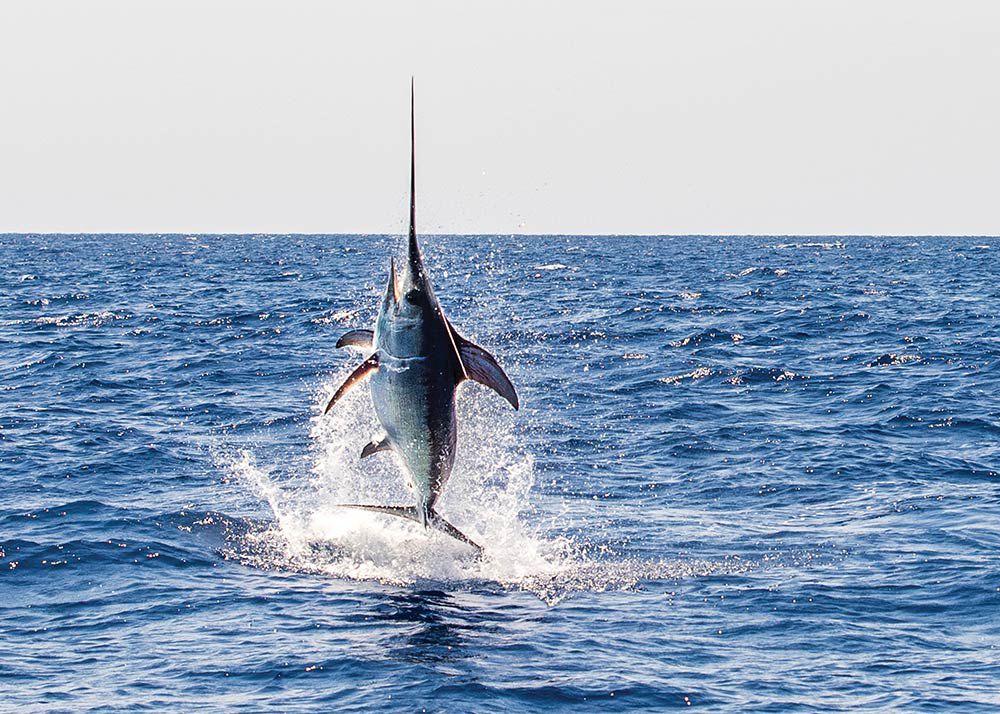Article Courtesy: saltwatersportsman.com | Originally Published: 6/19/2019 | Click here for original article
Daytime Swordfishing
It took longer for the bait to hit bottom than for us to get our first bite. Watching the rod tip bob rhythmically while the boat rocked back and forth, I didn’t notice the first take. “There he is!” Feder said, quickly retrieving 50 feet of line. “What? Where?” I was confused.
Feder stopped cranking, and the rod tip returned to a slow, steady bounce. This time I watched more closely. When the rhythm was interrupted by a slight but obvious tap, the whole crew shouted, “There he is!” Feder returned to the reel just as the rod tip bent into a deeper arch, and he proceeded to retrieve line until the drag began to slip.
For the next 1,000 feet, the fish came to the boat with only an occasional pause to pull some drag. But once the weight was within reach and Feder removed it from the rig, the comparison with catfishing ended. The swordfish—considerably bigger than the fight to that point had led me to believe—was suddenly invigorated, as though it’d been saving its energy for a brutal fight boatside. Feder deftly worked the reel while the hooked leviathan pulled every trick to regain its freedom: diving, charging, jumping, thrashing, and swimming in circles.
But luck was on our side and, after a half-hour with our hearts in our throats, Capt. Ross stuck the 472-pounder with a harpoon and Gaddy came off the bridge to finish the job with a gaff. Then Feder slipped the tail rope on the huge broadbill, we pulled it aboard through the fish door, and the entire crew erupted in loud celebration.
My first success with daytime swords makes the fishing sound like an easy endeavor, but the catch was the culmination of many years of effort. Twenty years ago, few anglers targeted broadbills off mid-Atlantic shores. My swordfishing experience was limited to a handful of overnight trips drifting through Norfolk Canyon. When daytime swordfishing came to my home waters, I tried a few times with buddies but never managed to seal the deal.
Gaddy admitted his road to success was long and bumpy. “I fell in love at first sight when I saw another crew land a 700-pound swordfish,” he recalls. That experience kicked off an obsession that sent Gaddy, an Oregon Inlet-based skipper, to target broadbills in some of the world’s hotspots.
The learning curve eventually led him to target swords back in his home waters. “We didn’t have much luck until we started fishing in late fall,” he remembers. But once he was in the right place doing the right thing at the right time, it all came together.
My story starts with Capt. Justin Wilson, partner at Ocean’s East Bait and Tackle in Virginia Beach. A dozen years ago, stories of Wilson’s daytime swordfishing adventures tempted some friends and me to give it a try. To verify the rumors, I caught up with Wilson during the offseason. “I owe it all to Vic Gaspeny,” he admitted. When the legendary Islamorada guide fished with Wilson in Virginia Beach, he brought his South Florida tactics. “We ended up pulling off a big fish on our first drop,” Wilson recalls.
The experience prompted Wilson to embark on a decade of developing techniques and game plans. Taking what he learned from top daytime deep-droppers around the world, he fine-tuned an effective system for mid-Atlantic swordfish.
Wilson starts swordfishing in July and wraps up in January. “You can catch them all year, but the best action is November to January,” he points out.
Fifty miles off the mid-Atlantic Coast, the continental shelf drops thousands of feet, and this precipice is pocked with canyons and seamounts. “You can pick almost any drop or hill to look for swords,” Wilson says, and he looks for bait or fish marks on his bottom machine. His best bites come in 1,000 to 1,600 feet of water.
Dropping a rig a quarter-mile takes teamwork. Wilson keeps the boat ahead of the rig while the mate controls the payout, stopping every few minutes to let the line come tight. When the rig is a few hundred feet from the bottom, he slows the descent. “We’ve caught fish hundreds of feet off the bottom; many times, one follows the bait,” Wilson explains.
His swordfish rig starts out with a 10/0 hook. “It took us years to find the right hook,” he admits. The traditional rig starts with a strip of belly meat or a whole squid. The past couple of years, Wilson’s team has experimented with the Hogy Swordfish Eel, an 18-inch soft plastic that withstands peckers and missed bites without damage. “Tournament anglers like it because they can fish a J hook under tournament rules,” Wilson adds.
Connecting with a swordfish over 1,000 feet down takes a combination of luck and skill. Wilson compares it to hooking a triple-digit-weight seatrout. “For such a large fish, it has a soft mouth,” he says. It requires the man on the reel to bring in line, then wait for a response. When the line comes tight and the rod doubles over, it’s time to crank like hell.
Another of Wilson’s tricks is setting the drag to 24 pounds for the initial fight. “If the hook is going to pull, I’d rather it happens in the first few minutes,” he says.
It’s common knowledge that swordfish save their strength until they are a few hundred feet from the boat, so the endgame is critical.
“We hit one fish with the dart, and it ran straight for the boat and wrapped the main line into the wheel,” Wilson says. His crew watched 300 feet of cord and a poly ball leave the boat, so they attached another 300 yards of cord and another buoy. “The fish took it all,” he remembers. They eventually worked all the cord in to claim their prize, but the story left an impression.
Capt. Tim Hagerich on Good Times out of Hatteras Harbor brought swordfish tactics he learned in South Florida to the canyons and ledges off North Carolina, and elects to fish two lines. He drops his first rig to the bottom, cranks up 50 feet, and uses a longline clip to attach a large foam buoy to the main line. He lets the buoy carry the first bait 100 to 150 feet from the boat, then drops the second rig and fishes it straight from the rod tip. “We troll at up to 6 knots,” he adds, periodically kicking the boat out of gear, letting the bait sink to the bottom before returning to trolling speed.









